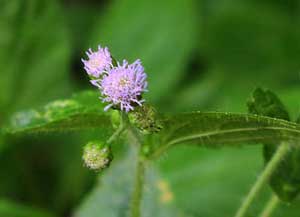Despite its difficult name and being far from a “rare find”, the pigweed plant is a valuable remedy for treating sinusitis. This plant exhibits anti-inflammatory, anti-edema, and anti-allergic effects in both acute and chronic phases.
 |
|
Pigweed – Ageratum conyzoides (Photo: divingcat) |
In Vietnam, sinusitis affects 15-20% of the population. The disease develops under the influence of climate, environment, humidity, living conditions, and individual sensitivity, and it frequently recurs. Treatment typically lasts 3-6 months, with some individuals requiring continuous treatment for several years with expensive Western medications. Each treatment course can cost millions of VND, making it unaffordable for many patients.
For a long time, folk remedies have recognized the effectiveness of the pigweed flower (also known as five-color flower, five-flavor flower, or stinking herb; scientific name: Ageratum conyzoides) in treating sinusitis.
Pigweed is a small plant with a hairy stem, growing 25-50 cm tall, and commonly found in rural areas. Its flowers are small and come in shades of purple and blue. The plant thrives in various soil types, with some areas seeing it cover entire fields. The entire plant is harvested, roots removed, and can be used fresh or dried. Pigweed has a high essential oil content. Animal experiments have shown that it possesses anti-inflammatory, anti-edema, and anti-allergic properties in both acute and chronic conditions.
Usage: Select fresh plants, wash them thoroughly, and let them dry. Crush them to extract the juice and soak cotton in it. Insert the cotton into the painful nostril for about 15-20 minutes. Remove the cotton to allow pus from the sinuses and nose to drain out, then gently blow your nose. Avoid forceful blowing, as this can cause mucus from the sinuses to travel through the connection between the nose and ear (known as the Eustachian tube), potentially leading to acute otitis media.
Currently, there are several medications extracted from pigweed, formulated as nasal drops, which are very convenient for users. However, patients should consult with an ear, nose, and throat specialist for an accurate diagnosis (to rule out any nasal tumors) and guidance on how to monitor their condition when using the medication at home.
ThS. Phạm Bích Đào

















































